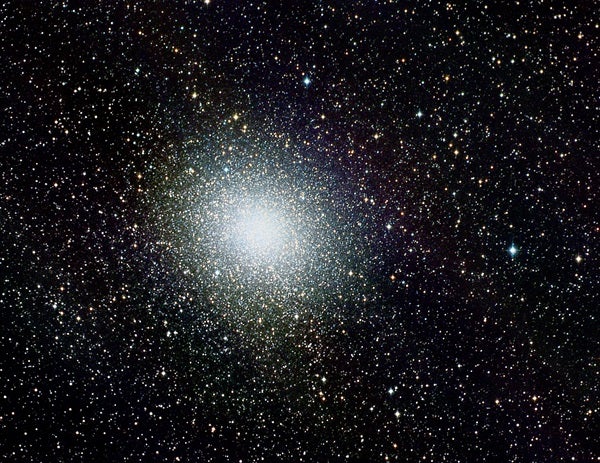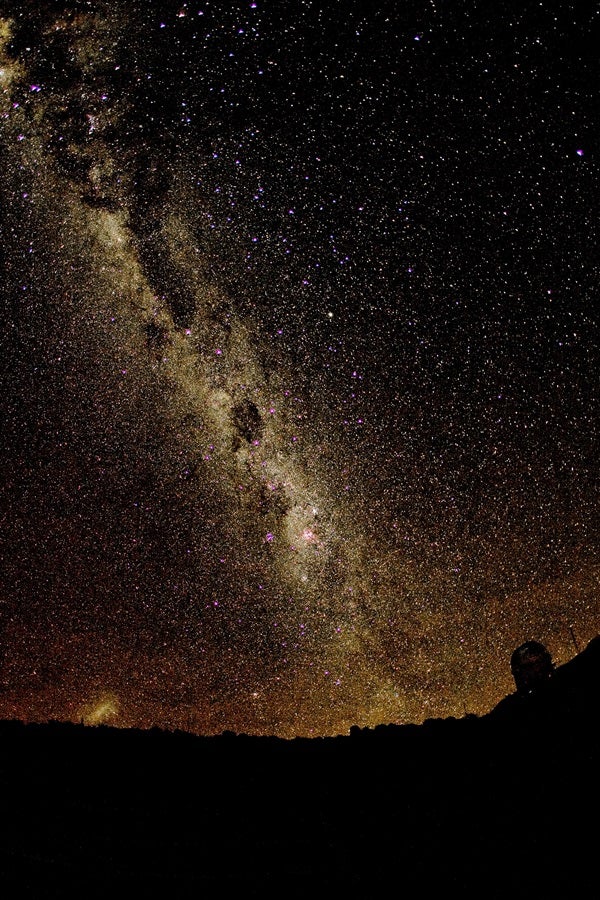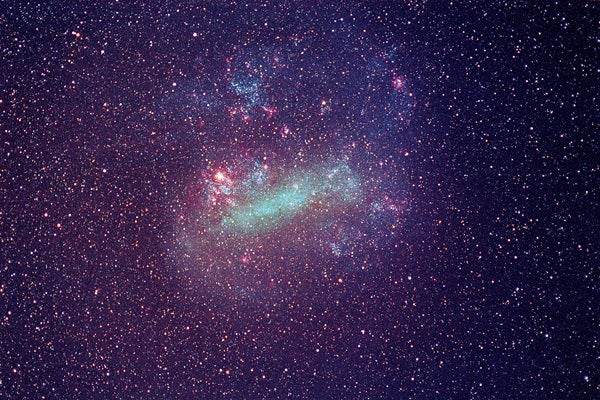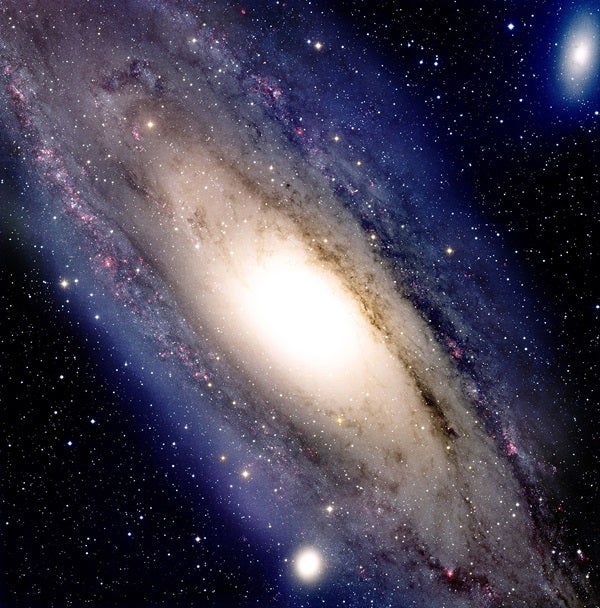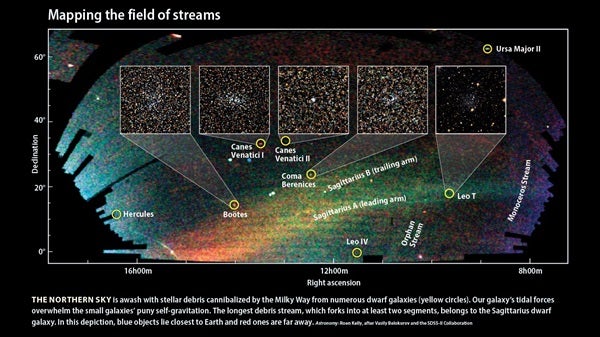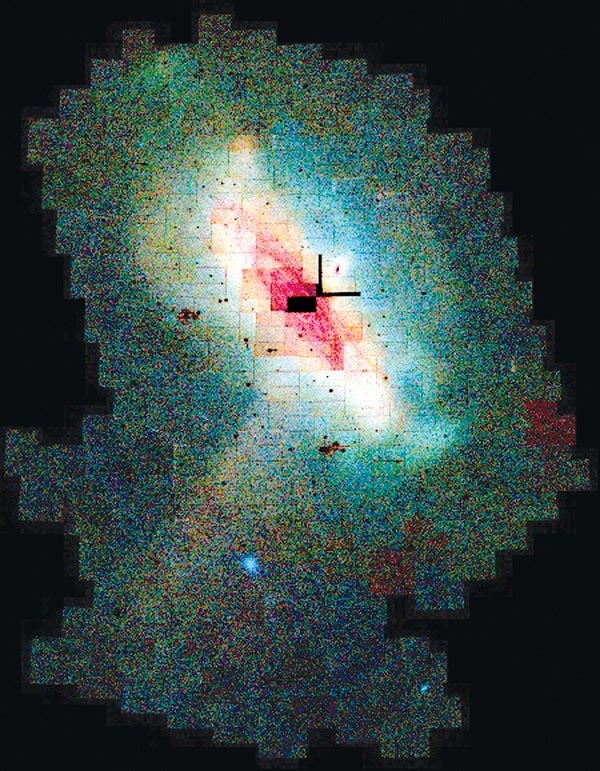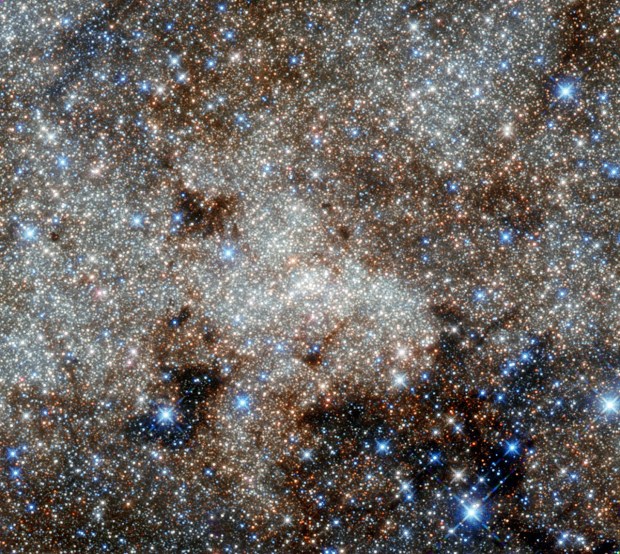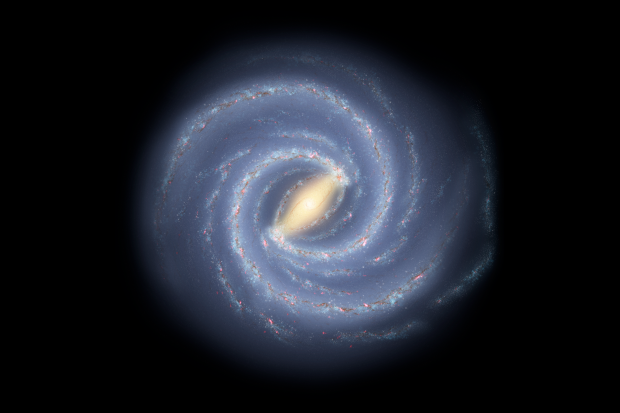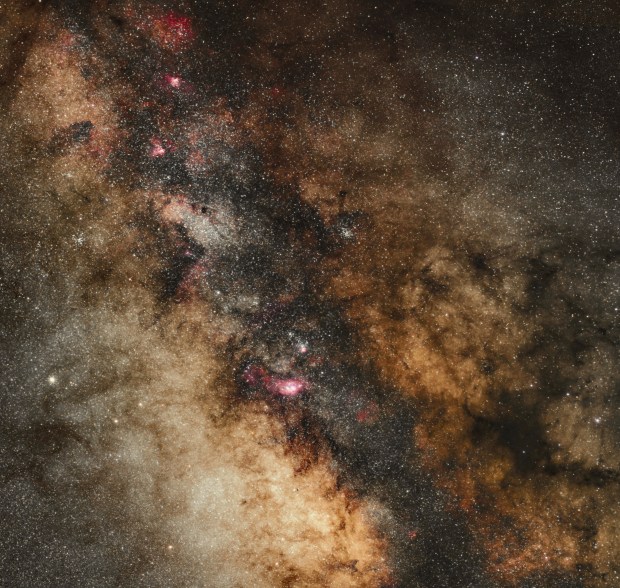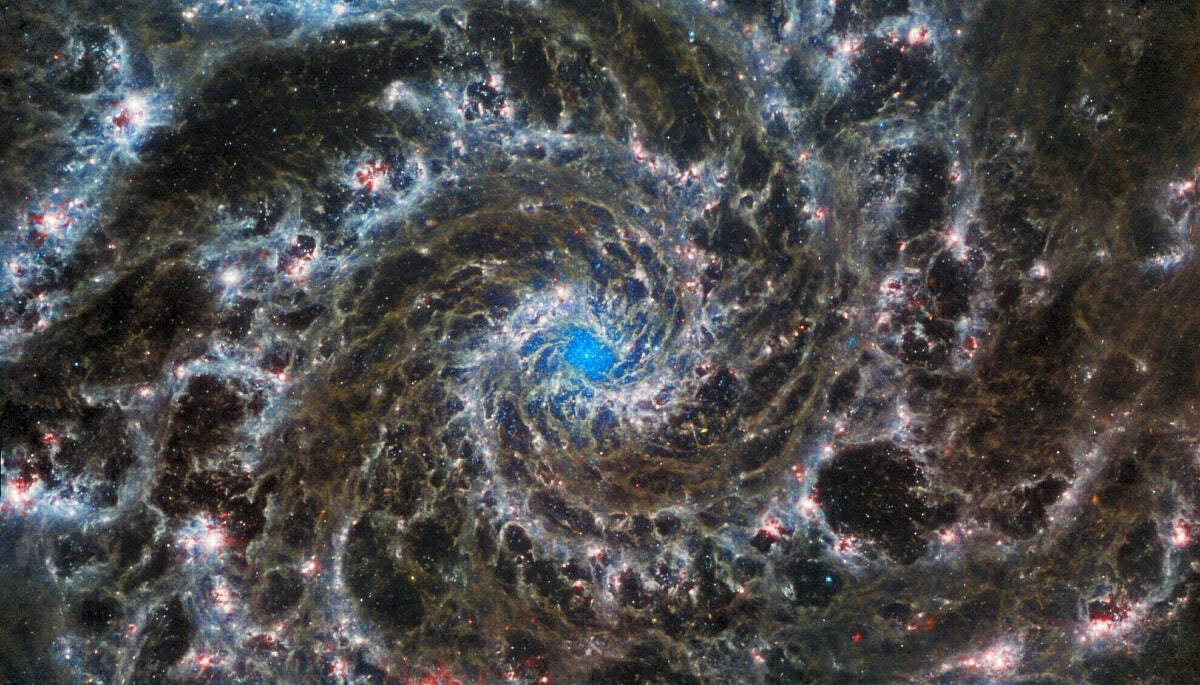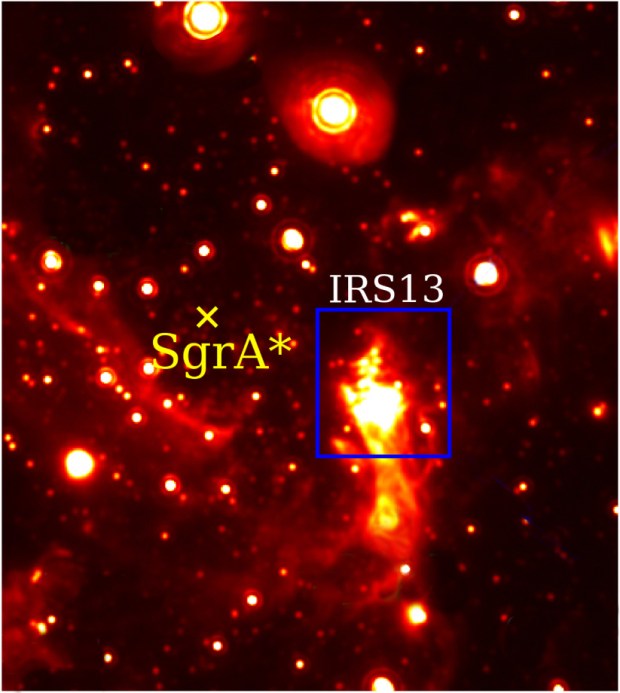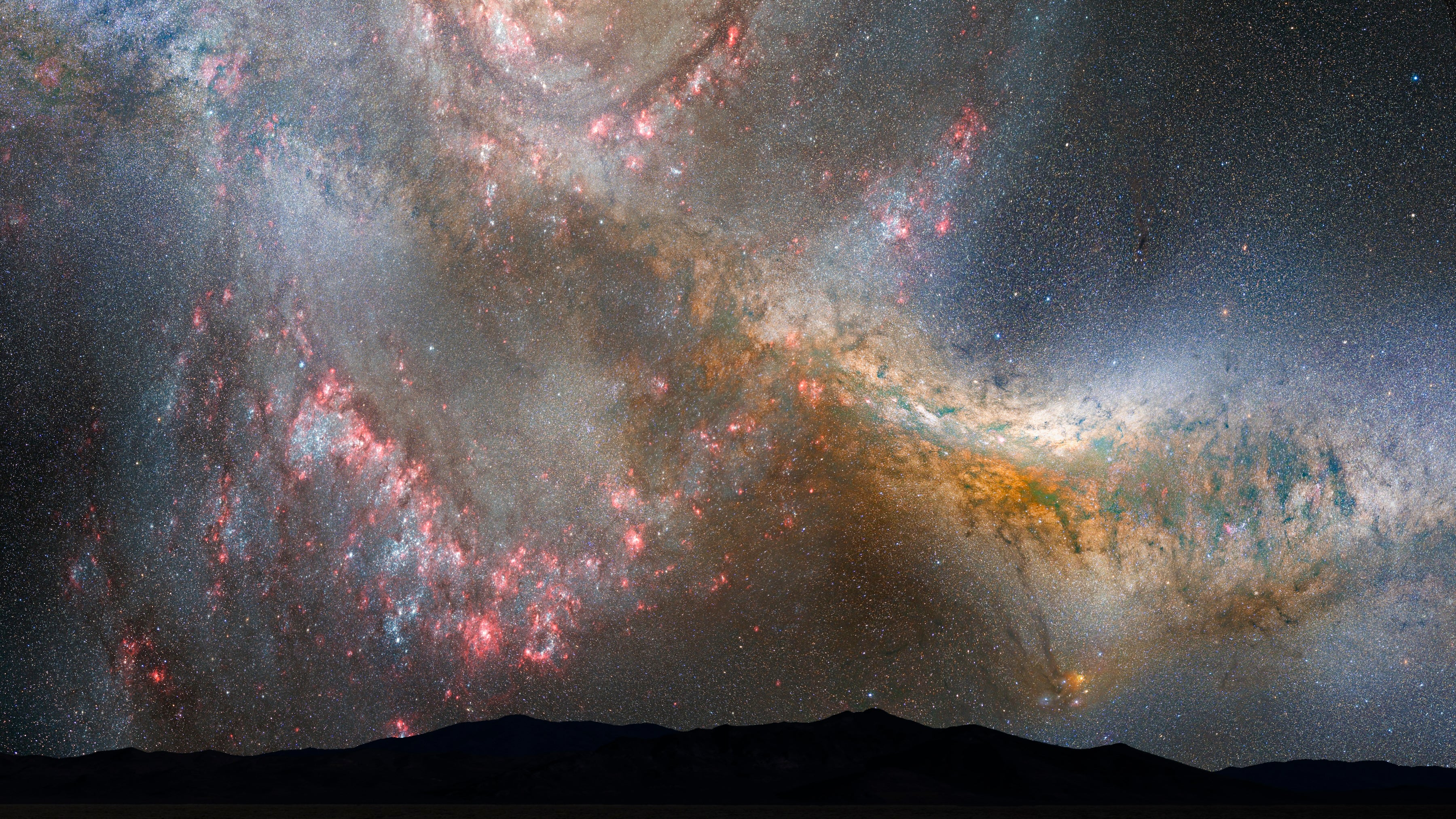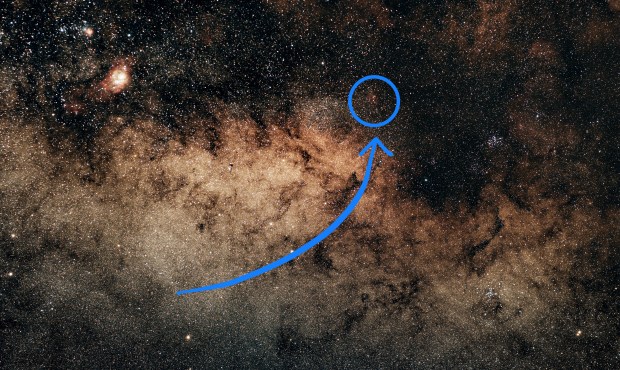On a clear moonless night, the arc of the Milky Way overhead seems the very picture of serenity. Yet its gentle glow masks a life of turmoil. Episodes of violence, plunder, and cannibalism pervade astronomers’ emerging picture of our galaxy’s history.
Unraveling this story, with the help of painstaking observations and sophisticated computer simulations, could shed light on how the Milky Way acquired its present form. It could also help astronomers understand galaxy evolution in general.
The classical view of the galaxy’s origin, proposed more than four decades ago, starts with a single large gas cloud that collapsed when the universe was in its infancy. In 1978, however, Leonard Searle and Robert Zinn, then at the Carnegie Observatories in Pasadena, California, introduced a new twist.
The astronomers suggested that some globular clusters — dense knots of hundreds of thousands of stars in the galactic halo — joined the Milky Way after its central regions and disk already had taken shape. Ever since, various astronomers have argued that certain globular clusters are stolen goods, wrested away from other smaller galaxies as they merged with the Milky Way.
Clusters orbiting the galactic center “backward” — opposite to the orbits of the Sun and most other stars — are among the most likely interlopers. Many researchers think Omega Centauri (NGC 5139), the most massive globular known, could be the nucleus of a disrupted dwarf galaxy.
This more chaotic picture agrees better with current theory about how galaxies evolved from an initially near-homogeneous universe. The favored model goes by the name “cold dark matter” (CDM). This theory assumes dark matter — the mysterious substance whose gravity dominates over normal matter — consists of slow-moving (hence “cold”) particles.
From the bottom up
The CDM scenario, explored in numerous theoretical calculations and simulations, suggests structure formed from the bottom up. Large galaxies grew from the mergers of smaller clumps. Galaxies grouped into clusters and still-larger superclusters. One challenge for the CDM model is that it predicts many more dwarf galaxies in our cosmic neighborhood than astronomers observe.
It could be that the Milky Way and other large galaxies, like the nearby Andromeda Galaxy (M31), already have gobbled up most of their smaller brethren or distorted them so much they are difficult to spot even in our own backyard.
A massive galaxy exerts powerful tidal forces because the gravitational pull acting on the near side of a neighbor significantly exceeds that acting on the far side. These forces overwhelm the gravity binding a dwarf galaxy together and rip it apart. The tides draw gas and stars into long trails or streams that eventually disperse. Once the “loot” mixes in with the big galaxy’s contents, tracing its origin proves far from easy.
The vast majority of mergers that built our galaxy probably happened early in its history. But the Milky Way continues to destroy and swallow its remaining neighbors.
Big news from small galaxies
The Magellanic Stream has often been held up as the poster child of an ongoing merger. The stream consists of gas stripped from two irregular satellite galaxies well known to Southern Hemisphere observers: the Large and Small Magellanic Clouds. First identified more than 40 years ago, the stream trails the motions of the galaxies for some 600,000 light-years. The so-called Leading Arm stretches between the clouds and our galaxy.
Some models suggest the Milky Way created these filaments. But a decade ago, Nitya Kallivayalil, then at MIT, and her colleagues found that the Magellanic Clouds are moving unexpectedly fast. Unless our galaxy has far more mass than we think, the clouds may be on their first pass — and tides alone likely could not produce the stream.
The Milky Way also seems to be disrupting other Local Group dwarfs. University of Virginia astronomer Steven Majewski leads one of several groups that have discovered tidal debris from several of these dwarfs, including those in the constellations Carina, Leo, Ursa Minor, and Sculptor.
Perhaps the most dramatic case of a cannibalized Milky Way satellite is the Sagittarius Dwarf Spheroidal Galaxy. Rodrigo Ibata, then a graduate student at Cambridge University, found it almost by accident.
In 1994, Ibata was studying the motions and chemical compositions of stars in our galaxy’s bulge. While collecting spectra of his sample stars at the Anglo-Australian Telescope in Australia, Ibata noticed a few of the reddest stars had velocities different from all the others. Even stranger, the stars appeared to be moving together. On the next couple of nights, he took spectra of more red stars. They all shared the same unusual motion.
When Ibata returned to Cambridge, he and his colleagues scanned archival photographic plates of that region of sky, then plotted the positions of red stars similar in brightness to those he had found with peculiar velocities. This exercise revealed the contours of a hitherto unknown galaxy. It lies roughly perpendicular to the Milky Way’s disk and about 100,000 light-years away, on the far side of the galactic center.
It had been hiding behind the Milky Way’s thick veil of stars and dust. What’s more, the newly found dwarf spheroidal galaxy, named Sagittarius after the constellation that contains its center, has a rather contorted appearance. This represents clear evidence of bullying by the dwarf’s massive neighbor.
During the past 20 years, astronomers have attempted to chart the dwarf galaxy’s full extent. Recent maps show its debris scattered in a giant arc that wraps around the Milky Way. Ibata’s team and others argue that several globular clusters previously thought to belong to our galaxy actually came from the Sagittarius dwarf. Other stolen clusters and individual stars may exist, but they’re already so well mixed in with the Milky Way’s own that astronomers can’t trace their origins.
The surprise discovery of the Sagittarius dwarf raised the possibility others like it may lurk undetected. Astronomers imagined spaghetti-like strands crisscrossing the Milky Way, each filament retaining a faint memory of the path taken by its long-since-destroyed parent galaxy or globular cluster. Scientists tried to identify streams of stars with peculiar motions and odd chemical abundance patterns, which might betray their alien origins.
 Astronomy
Astronomy magazine has teamed up with Emmy Award-winning artist Jon Lomberg to offer
Galactic Tidal Star Streams. This poster is the first and only artwork showing galactic tidal star streams, which occur as larger galaxies rip stars away from smaller ones and consume them. You can get this 16” x 20” print at
MyScienceShop.com today!
The tides turn to Sloan
For researchers in pursuit of these elusive fossils, the Sloan Digital Sky Survey has turned out to be a treasure trove. Initiated in 2000 and now in its fourth phase, the multi-wavelength survey covers one-third of the sky.
Michael Odenkirchen and Eva Grebel, then at the Max Planck Institute for Astronomy in Germany, and their colleagues quickly discovered two tidal trails. The trails emerge from a sparse and remote globular cluster cataloged as Palomar 5. One of these trails has now been traced across more than 20° of sky, spanning some 25,000 light-years.
Scientists think Palomar 5 lost much of the observed debris in the past 2 billion years. Simulations suggest this cluster will break apart completely the next time it crosses the Milky Way’s disk, just 100 million years from now. Other researchers have since identified an even larger debris arc associated with the globular cluster NGC 5466.
In 2003, Heidi Jo Newberg of Rensselaer Polytechnic Institute in Troy, New York, Brian Yanny of Fermilab outside Chicago, and their colleagues reported the discovery of a “ring” of stars beyond the visible edge of the Milky Way’s disk. They named it the Monoceros Stream because its center lies toward that constellation.
The Monoceros Stream’s stars stood out in the Sloan data because they have unusual colors. The colors arise from the stars’ lack of heavy elements — meaning all those natural elements heavier than helium. Some scientists think the stream originates from a dwarf galaxy in the constellation Canis Major that’s being torn apart by the Milky Way’s gravitational tides.
In 2006, Mario Juric of Princeton University and his colleagues reported discovery of a remarkable increase in stellar density toward the constellation Virgo. The structure turned up in a 3-D map of about 48 million stars the team made from Sloan data.
At an estimated distance of 30,000 light-years, the density structure lies well within the Milky Way’s confines. The most likely explanation is that these “extra” stars belong to a slowly dissolving dwarf galaxy.
A team led by Kathy Vivas of the Center for Astronomical Investigations in Venezuela had noticed hints of such a beast a few years earlier. The researchers were searching for a type of pulsating variable star known as RR Lyrae stars. “We saw a high density of RR Lyrae stars in the region — more than 20 of them — and speculated that they belonged to a small galaxy being cannibalized by the Milky Way,” she says. In light of the Sloan findings, “It appears that the stellar stream we detected is itself part of a larger structure.”
Field of streams
Later in 2006, Cambridge University’s Vasily Belokurov and Daniel Zucker and their collaborators identified a number of other trails and lumps in Sloan images taken toward the north galactic pole, not far from the direction of the previously known Sagittarius and Monoceros streams. So many tidal trails populate this region that the researchers dubbed it the “field of streams.”
One of these trails covers 30° of sky. It contains two globular clusters deficient in heavy elements and could be the “orphan” of yet another disrupted dwarf galaxy. At least three more faint Milky Way satellites, all showing signs of distortion, turn up in the Sloan survey. Taken together, these findings are “a striking demonstration of multiple merger events going on in the Milky Way right now,” Yanny says.
Astronomers now have little doubt our galaxy has enriched itself at the expense of others. “In fact, the majority of globular clusters might be relics of accretion events,” claims Julio Navarro, an astrophysicist at the University of Victoria.
As supporting evidence, Navarro points to the agreement between the distribution of globular clusters around the Milky Way and the density profile of accreted stars in his group’s simulations of
galaxy formation. He finds a similar match between models and observations of our galaxy’s near twin, the Andromeda Galaxy. This suggests galactic cannibalism might be rampant.
Our exotic neighbors
But, the “stolen goods” may not be found just in the galaxy’s outer reaches. Some interlopers may lurk in the solar neighborhood, too. Timothy Beers of the University of Notre Dame and his collaborators identified a group of stars in the Milky Way’s disk that shares the chemical abundance pattern of stars in Omega Centauri, and may have come from the same disrupted parent galaxy.
Another such grouping includes the relatively nearby red giant star Arcturus. The members of this group move through space in a similar manner to one another, but much slower than most other stars in their vicinity. They also share a distinct chemical imprint.
“You can make a plausible though not conclusive case that these stars came from a disrupted satellite galaxy,” says Navarro. His simulations show tidal debris not only can accumulate in the galaxy’s halo, but also contribute to the disk. “It may be that most metal-poor stars in the Milky Way’s disk originated in various accreted satellites,” he argues.
Sloan researchers have also discovered two distinct populations of stars in the galaxy’s halo. The groups orbit the galaxy’s center in opposite directions, providing more evidence for multiple mergers in the past. Unfortunately, it’s probably impossible to pin down just how many neighbors the Milky Way has devoured during its long history. There could have been hundreds of small early mergers, or just a few major collisions that dominated.
A study of 20,000 stars in four dwarf spheroidal galaxies found a puzzling paucity of extremely metal-poor stars. This suggests the Milky Way’s current small neighbors may differ fundamentally from those it devoured in the distant past.
Detailed observations of large numbers of stars in the galactic halo could provide more clues to the Milky Way’s history. A survey project known as RAVE, for RAdial Velocity Experiment, has measured the velocities and compositions of 483,330 stars. Meanwhile, Sloan’s APOGEE-2 survey will collect spectra of another 300,000 stars in both the northern and southern skies by the time it wraps up in the autumn of 2020.
Our galaxy clearly has had a colorful, if not dramatic, history. But the story is far from complete. The challenge for astronomers will be to weave it together from a million pieces scattered in space and time.
The cannibal next door
With evidence of the Milky Way’s cannibalism all around us, it seems logical our galaxy’s near twin, the massive Andromeda Galaxy (M31), should show signs, too. The nearest large galaxy to our own, the spiral behemoth M31, lies approximately 2.5 million light-years away. That vast distance makes it difficult for astronomers to discern relic stars left behind by past mergers.
Despite the challenges, astronomers have made progress. In 1993, a team led by Tod Lauer of the National Optical Astronomy Observatories in Tucson discovered what appear to be two dense knots — called a double nucleus — at M31’s center. The researchers needed the Hubble Space Telescope’s sharp eyes to separate the two structures. Some astronomers speculated that one of the clumps originated in a satellite galaxy that had collided with M31.
One problem with this story: The two clumps should have merged in less than 100 million years — a short time compared with the several-billion-year age of the stars in those knots. Most researchers now prefer an alternate explanation, proposed by Scott Tremaine of Princeton University. He thinks both knots belong to a single elongated disk of stars having a supermassive black hole at one focus.
More convincing evidence of M31’s cannibalism came to light in 2001. At that time, astronomers were conducting a deep panoramic imaging survey of the Andromeda Galaxy’s halo with the 2.5-meter Isaac Newton Telescope on La Palma in the Canary Islands. Rodrigo Ibata of Strasbourg Observatory in France and his collaborators discovered an extended stream of stars protruding from Andromeda. Astronomers have dubbed this feature
the Giant Southern Stream.
Some researchers have proposed that the Giant Southern Stream consists of stars torn from one of Andromeda’s two close companions, the dwarf satellite galaxies M32 and NGC 205. According to Puragra Guhathakurta of the University of California at Santa Cruz, there’s no hard evidence for this explanation.
The more likely scenario, Guhathakurta says, is that Andromeda has completely devoured a dwarf galaxy. If this is true, the Giant Southern Stream may be just one segment of an extended debris trail looping around the giant galaxy. The trail marks the dwarf galaxy’s extended death spiral into Andromeda.
A team led by Guhathakurta has reported evidence linking the Giant Southern Stream to several other locations in Andromeda where large numbers of stars appear to move as a group. The researchers believe these features are parts of a continuous star stream. “We think we are seeing the debris trail of a small, chemically rich galaxy that fell into Andromeda,” Guhathakurta says.
More recently, the Sloan survey revealed a giant, diffuse clump of stars just outside M31’s disk that could be the remnants of another satellite galaxy being torn apart by Andromeda’s tides. The exact nature of this structure remains a mystery, however. Many astronomers continue to search Andromeda for clues to its voracious and chaotic history.


